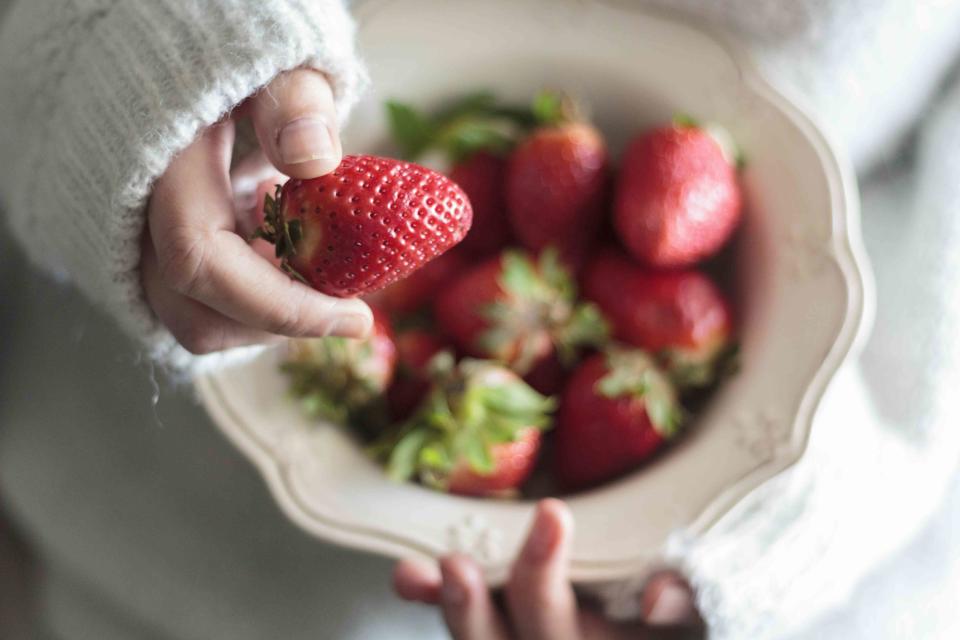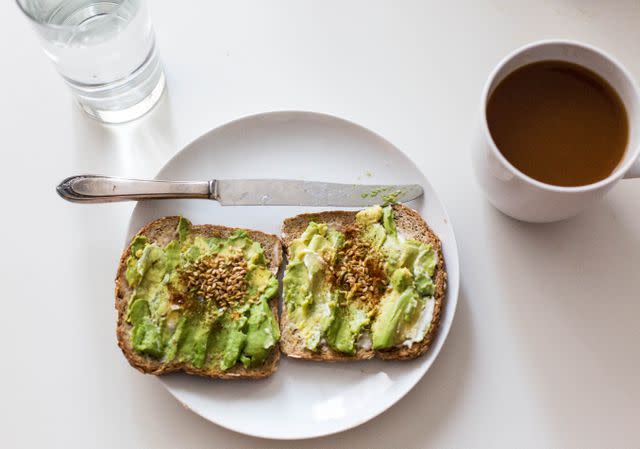The 12 Fruits and Vegetables With the Highest Pesticide Residues
To avoid potentially toxic pesticide exposure, buy these items organic whenever possible.

It has been 30 years since the National Academies of Sciences published their landmark study revealing the dangers of pesticides to children. Yet here we are, with 75% of non-organic fruits and vegetables sold in the United States coming with notable traces of potentially toxic agricultural chemicals.
Federal oversight on the issue has been infamously lean—and lagging far behind other countries. A 2019 study published in Environmental Health found that of the pesticides used in U.S. agriculture in 2016, 322 million pounds were of pesticides banned in the European Union, 26 million pounds were of pesticides prohibited in Brazil, and 40 million pounds were of pesticides banned in China. “The majority of pesticides banned in at least two of these three nations have not appreciably decreased in the USA over the last 25 years,” note the study authors, “and almost all have stayed constant or increased over the last 10 years.”
In the U.S., the onus for avoiding pesticides deemed toxic enough to ban in other countries falls on the consumer. But thankfully, we have the nonprofit Environmental Working Group’s (EWG) annual Shopper’s Guide to Pesticides in Produce to help us navigate the way.
The Shopper’s Guide crunches the numbers on the latest fruit and vegetable testing data from the Department of Agriculture (USDA) and the Food and Drug Administration (FDA). The 2023 edition includes data from 46,569 samples of 46 fruits and vegetables, covering 251 different pesticides.
The analysis results are turned into two lists of non-organic (conventionally grown) produce items: The Dirty Dozen, which highlights the items with the highest pesticide loads, and the Clean Fifteen, which calls out the fruits and vegetables with the lowest pesticide residues. Both are based on federal agencies’ tests.
“Despite the abundance of science linking exposure to pesticides with serious health issues, a potentially toxic cocktail of concerning chemicals continues to taint many of the non-organic fruits and vegetables eaten by consumers,” said Alexis Temkin, Ph.D., EWG toxicologist.
The findings underscore the need for stronger regulations around and oversight of how pesticides are used on food crops, says EWG.
This year we have two newcomers to the naughty list: Blueberries and green beans, coming in at numbers 11 and 12. Both had concerning concentrations of organophosphate insecticides. Ninety percent of both items samples had residues of pesticides; some samples revealed traces of up to 17 different pesticides.
Nearly 80 percent of blueberry samples had two or more pesticides. Phosmet was detected on more than 10 percent of blueberry samples and malathion on 9 percent. Both are organophosphates that are toxic to the human nervous system, especially children’s developing brains. In 2015, malathion was classified as probably carcinogenic to humans by the International Agency for Research on Cancer,” writes EWG.
Meanwhile, the nonprofit notes, “More than 70 percent of green beans had at least two pesticides, with a combined 84 different pesticides found on the entire crop. Six percent of samples showed residues of acephate, a toxic pesticide the Environmental Protection Agency banned for use on green beans more than 10 years ago. Green beans also had traces of several pesticides banned in the European Union but allowed in the U.S.”
The item with the highest amount of pesticides was strawberries. (Insert heartbreak emoji here.) The USDA’s strawberry tests revealed that 99% of conventional strawberries tested had detectable residues of at least one pesticide. Around 30% had residues of 10 or more pesticides, while the dirtiest strawberry sample had residues of 22 different pesticides and breakdown products.
The Dirty Dozen
These are the 12 fruits and vegetables that contained the highest amounts of pesticide residues. EWG recommends buying organic versions of these products when possible. (Treehugger also advises checking in with vendors at your local farmers market—often times their produce may not be certified organic but is still grown with no or minimal pesticide use.)
Strawberries
Spinach
Kale, collard & mustard greens
Peaches
Pears
Nectarines
Apples
Grapes
Bell & hot Peppers
Cherries
Blueberries
Green Beans
The Clean Fifteen

While it’s valuable to know what produce items are carrying the highest pesticide loads, the Clean Fifteen list may be even more useful for more people. Not everyone has the access or resources to purchase organic food—so knowing which items are OK to buy in conventional form can go a long way in reducing one’s pesticide exposure without having to rely on organic items. The following fruits and vegetables had very low or no traces of pesticides.
Avocados
Sweet corn*
Pineapple
Onions
Papaya*
Sweet peas (frozen)
Asparagus
Honeydew melon
Kiwi
Cabbage
Mushrooms
Mangoes
Sweet Potatoes
Watermelon
Carrots
Note: "A small amount of sweet corn, papaya, and summer squash sold in the United States is produced from genetically modified seeds," writes EWG. "Buy organic varieties of these crops if you want to avoid genetically modified produce."
Takeaways
Buy Organic When You Can
If you do have the ability to buy more organic food, there are plenty of reasons to do so—the fewer pesticides being used, the better for the farm workers, pollinators, soil, and more. (For example, much of the last decade's declining honey bee problems have been traced to pesticide use.)
Related:Is Organic Food Worth the Cost?
Don't Be Afraid to Eat Produce!
Reports and lists like these can be quite disconcerting with their talk of toxic chemicals and the like. But the healthiest diets rely on an abundance of fruit or vegetables, and it's important not to shun produce because of potential pesticide exposure.
“Everyone—adults and kids—should eat more fruits and vegetables, whether organic or not,“ Temkin said. “A produce-rich diet provides many health benefits."
Now we just need the federal government to exercise more oversight on pesticide use to make healthier produce available to all.
For more information, see EWG's full listings and reports for the Dirty Dozen and Clean Fifteen.
Read Next:How to Tell if Produce Is Organic in 2 Seconds Flat

